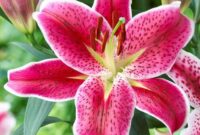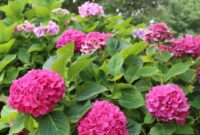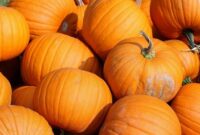The cheerful Shasta daisy is a classic perennial. It looks similar to the familiar roadside daisy, but has larger and more robust blooms. Here’s how to grow Shasta daisies in your garden!
About Shasta Daisies
A European native, Shasta daisies are now naturalized throughout North America. Like clockwork, these daisies return every spring or early summer and bloom until early fall. They can be aggressive growers, so if you don’t want them spreading, choose varieties that don’t produce viable seed or remove flowers before they go to seed. Because they are capable of spreading and are non-native, consider keeping them contained in garden beds away from wild areas.
Shasta daisies tend to form clumps that are 2 to 3 feet tall and 1 to 2 feet wide. They bear all-white daisy petals, yellow disk florets, and contrasting glossy, dark green leaves. Shasta daisies are terrific as cut flowers, as their blooms can last a week or more in arrangements.
Black bees on the clover-heads drowsily clinging,
Where tall feathered grasses and buttercups sway;
And all through the fields a white sprinkle of daisies,
Open-eyed at the setting of day.
–Abba Woolson
When to Plant Shasta Daisies
- Sow seeds in containers in a cold frame in autumn or spring.
- If you seed directly, expect blooms the following spring after one season’s growth.
- If purchasing a plant in a container, plant in spring or early fall.
Choosing and Preparing a Planting Site
- Grow in full sun for best blooms.
- Soil should be moderately fertile—too rich and you’ll get more vegetation than flowers. The soil should also be moist, but well-drained.
- Loosen the soil to a depth of 12 to 15 inches, then mix in a 2- to 4-inch layer of compost.
How to Plant Shasta Daisies
- Space plants 1 to 2 feet apart. Dig a hole twice the diameter of the container.
- When placing plant in the hole, make sure the top of the root ball is level with the soil surface.
- Fill around the root ball and firm the soil.
- Water thoroughly.
- Taller plants may need support/staking.
How to Grow Shasta Daisies
- Water during the summer only if rainfall is less than 1 inch per week. Daisies are generally tolerant of dry spells once they are established.
- Every spring, apply some compost and mulch to help control weeds.
- As flowers fade, deadhead to extend the blooming season.
- After the first killing frost, cut stems back to an inch or two above the soil line. (See local frost dates.)
Dividing Daisies
To keep daisies blooming their best, plan to divide them every 2 to 3 years in early spring (before flowers appear) or in late summer or early fall (after flowers fade). Signs that a plant should be divided include:
- Less-vigorous foliage growth
- Smaller flowers or fewer flowers overall
- Parts of the plant appear sparse or dead (especially the center of a clump)
How to Divide Daisies
- Use a spade or garden fork to loosen the soil around the plant, then gently remove it from the soil, doing your best to leave most roots intact.
- Brush or shake off soil from the roots. Then, using a sharp knife or pruning shears, divide the plant into two or more pieces, ensuring that each piece has at least a few stems and healthy-looking roots. Discard any diseased or damaged pieces.
- Replant the divisions as desired (spaced about 1-2 feet apart).
Daisies are generally low maintenance and disease resistant. However, the following may occasionally be troublesome:
- Aphids
- Slugs
- Earwigs
- Chrysanthemum nematode
- Leaf spots
- ‘Becky’ is a classic variety with large flowers that grows to about 3 feet tall.
- ‘Cobham Gold’ is a popular variety with double flowerheads and a yellow disc carried atop 2-foot stems.
- ‘Horace Reed’ is an elegant daisy with double white flowerheads and incurved disk florets.
- ‘Snow Lady’ is a fast-growing, erect, bushy perennial that blooms the first year from seed and produces single white flowerheads in the summer.
- Shasta daisies make for a lovely cut flower, lasting a week or more in arrangements.
- Daisies are one of the April birth flowers. They are also said to symbolize innocence and hope. Learn more flower meanings here.




